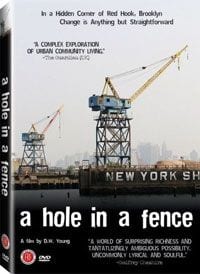
When a vacant lot filled with squatters, graffiti tags and trash gets torn down, who loses?
Developers and police may disagree, but A Hole in the Fence, D.W. Young’s documentary about the Red Hook section of Brooklyn, makes the case that everyone is hurt a little bit when spaces like the lot – the nooks and crannies that give a neighborhood character and tell the community’s story– give way to parking lots and big box stores.
The fence in the title refers to the scrap and cinder blocks that conceal the lot from the street, making it a prime hideaway for homeless people and graffiti artists. But the lot is prime real estate complete with a view of the Statue of Liberty, and Young wonders how it has remained untouched by development for so long.
That’s a question easily asked about Red Hook itself. When A Hole in a Fence was filmed, locals who took more than a little bit of pride that their community has remained gritty and working-class were nervously contemplating the neighborhood’s future. A controversial IKEA furniture store was about to be constructed on land adjacent to the vacant lot, one of a string of developments that seemed poised to take over Red Hook’s crumbling industrial waterfront.
Through clever use of a neighborhood map and using the lot as his focal point, Young turns his camera on the people and places that will be most impacted by IKEA and the sea change the store is likely to create in terms of traffic and interest in Red Hook.
We meet Benjamin Uyeda, a young architect who temporarily builds a shelter and moves into the lot as part of a university project intended to combine urban planning with activism. Uyeda and his collaborators eventually give their shelter, which has its own primitive heating and drainage system, to one of the lot’s semi-permanent residents.
Across the street from the planned IKEA entrance is a nonprofit that promotes sustainable development. The executive director is skeptical about how the big box store will benefit the community economically, but also sees potential for fruitful collaboration between his group and the retailer.
At a nearby park, older residents hope the young will take jobs at the store. The young people plan to visit IKEA – but only to create spray-painted expressions of their displeasure at losing the lot as a tagging spot.
A Hole in a Fence clocks in at less than an hour and much of the film feels like Young simply uploaded his raw footage into a computer and pressed “play”. Young’s technique fits the honest, unfiltered nature of many of the interviews (“Can I say that?” one black Red Hook asks after lamenting the influx of white yuppies and hipsters in the neighborhood. He doesn’t wait for an answer before continuing to make his point.)
The director’s affection for this neighborhood is clear, particularly after viewing the additional film and photos of the rough but striking landscape that are included on the DVD. But the documentary feels scattered, as if Young couldn’t bring himself to edit out any of the fascinating people and places he found in Red Hook.
The coming of gentrification and sprawl to Red Hook is like an earthquake that generated shockwaves throughout the neighborhood. Young only focuses on three or four of these “shockwaves”, but that’s almost too many for a film this short. As soon as the audience has a chance to fully absorb one story, the filmmakers have moved up the street to talk to someone else.
About two-thirds of the way through, Young turns his attention to a dry dock set to be demolished to make way for IKEA’s parking lot. The narrative clearly could have been a documentary unto itself and contains one of the film’s most bitterly laughable moments: the revelation that IKEA promised to “preserve” the dry dock by painting its outline, murder victim style, onto the concrete parking lot. The dry dock story is an interesting tangent, but it takes the documentary away from its heart, the abandoned lot.
At the end of A Hole in the Fence, the abandoned lot’s future – and the neighborhood’s — is unclear. It’s a fitting conclusion for a documentary that is more of a beginning than a fully-realized film.

![Call for Papers: All Things Reconsidered [MUSIC] May-August 2024](https://www.popmatters.com/wp-content/uploads/2024/04/all-things-reconsidered-call-music-may-2024-720x380.jpg)



